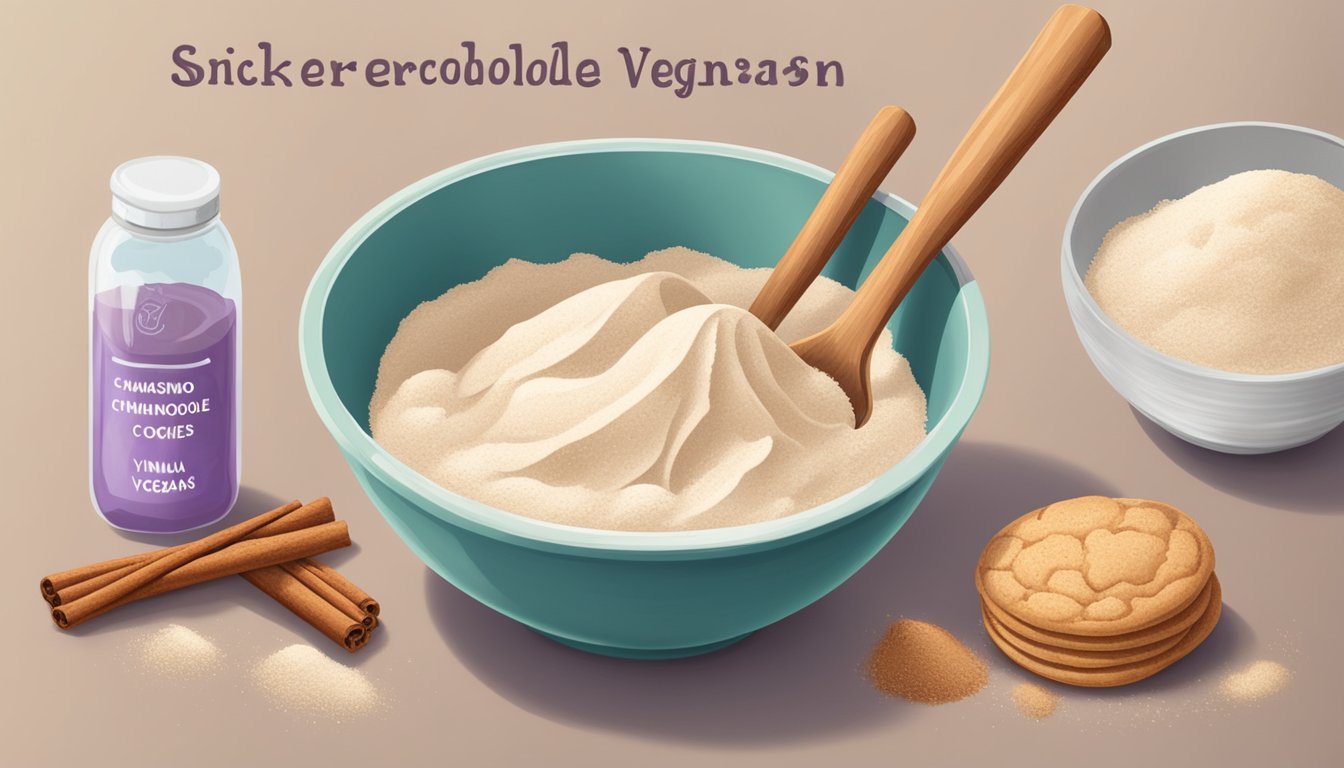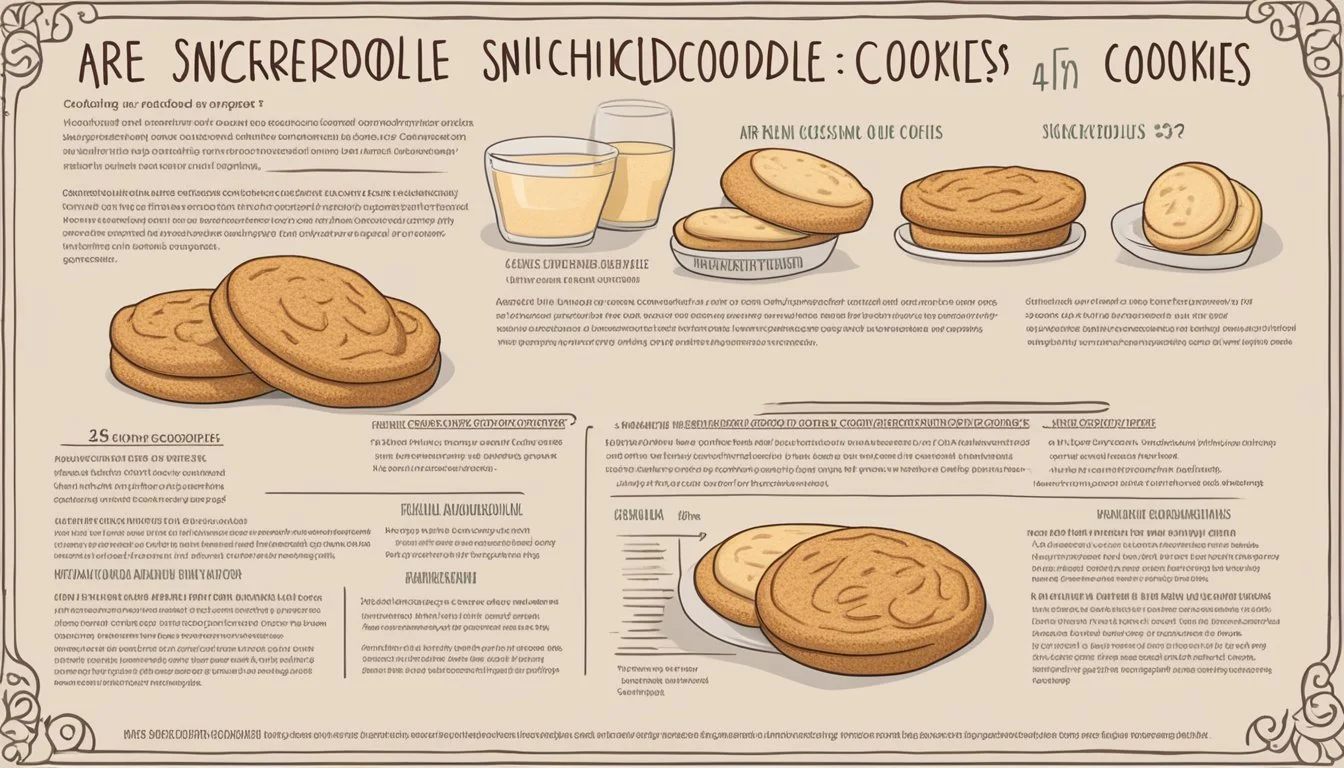Are Snickerdoodle Cookies Vegan?
Unveiling the Ingredients
Snickerdoodle cookies, traditionally characterized by their cracked surface and coating of cinnamon sugar, are a timeless dessert favorite. Their soft and puffy texture, often achieved with ingredients like butter, eggs, and cream of tartar, has delighted palates for generations. However, these classic components are not vegan-friendly, which raises the question of whether snickerdoodle cookies can align with a vegan diet.
In response to the growing demand for plant-based options, many bakers have successfully created vegan versions of this beloved treat. These cookies maintain the signature flavor and texture of traditional snickerdoodles while adhering to vegan standards. Innovations in baking have facilitated the substitution of eggs with flaxseeds or chickpea brine, and the exchange of regular butter with plant-based alternatives.
Adapting snickerdoodle recipes to fit vegan dietary restrictions does not compromise on the dessert’s charm, making it possible for everyone to enjoy this classic cookie. Vegan snickerdoodles are now widely accessible, with numerous recipes available that cater to the plant-based community. Whether through specialty bakeries or homemade recipes, vegan snickerdoodles ensure that the cookie's essence is preserved without the use of animal products.
Understanding Snickerdoodle Cookies
Snickerdoodle cookies are a traditional treat known for their cinnamon-sugar coating and distinctively soft, chewy texture. These butter cookies have carved out their place in baking history and continue to be a popular choice among cookie enthusiasts.
History and Tradition
Snickerdoodles originated in the late 19th century and have become a staple in American baking. Often associated with holidays and festive occasions, they stand out from other cookies due to their unique name and flavor. The name “snickerdoodle” is thought to be of German origin, with no direct connection to the confectionery ingredient, Snickers. Traditional snickerdoodles comprise simple ingredients: butter, sugar, flour, and eggs, with a distinct addition of cream of tartar which gives them their notable tang.
Characteristics of Snickerdoodles
A signature feature of snickerdoodles is their chewy and soft texture, typically achieved by the ratio of butter to sugar and the presence of cream of tartar. Before baking, the dough balls are rolled in a mixture of cinnamon-sugar, coating them in a sweet, spiced layer that crisps slightly in the oven. The cinnamon adds warmth and depth to the cookie’s flavor profile, distinguishing it from other butter cookies.
Snickerdoodle Variants
Over time, various adaptations of the classic snickerdoodle have emerged, including options that cater to dietary restrictions such as vegan snickerdoodles, which replace traditional ingredients like butter and eggs with plant-based alternatives. Gluten-free variants also exist, substituting wheat flour with alternative flour blends. Despite these adaptations, the cookies retain the defining characteristics that make snickerdoodles a perennial favorite: a moist, soft interior, and a cinnamon-sugar coated exterior.
Ingredients in Traditional Snickerdoodles
In traditional Snickerdoodle cookies, several key ingredients come together to create their signature taste and texture, which includes a soft, chewy interior with a slight tang and a warm cinnamon-sugar exterior.
Key Components
The foundation of Snickerdoodle cookies begins with:
Flour: Acts as the structural base of the cookie.
Sugar: Granulated sugar is used both within the dough and for coating the cookies.
Butter: It contributes to the richness and tender crumb.
Eggs: They provide moisture, act as a binder, and help the cookies rise.
Vanilla Extract: Adds a hint of vanilla flavor to the dough.
Role of Cream of Tartar
Cream of Tartar plays a vital role in Snickerdoodles by:
Reacting with baking soda to provide leavening.
Imparting the classic tangy flavor that distinguishes Snickerdoodles from other sugar cookies.
Flavor Profile
The flavor profile of traditional Snickerdoodles features:
A cinnamon-sugar coating that gives the exterior a warm and sweet spiciness.
A tangy undertone achieved through the cream of tartar, setting them apart from other sweet treats.
Vegan Baking Essentials
When creating vegan snickerdoodles, or any vegan baked goods, the choice of ingredients and their substitutes is crucial to ensure the desired taste and texture. The selection of effective vegan alternatives is key to successful vegan baking.
Vegan Substitutes
Vegan butter: A must-have in vegan baking, vegan butter can be used in place of traditional butter to give snickerdoodles their characteristic soft, chewy texture.
Non-dairy milk: Options like almond, soy, or oat milk are suitable for any recipe calling for milk, providing moisture and binding.
Flax egg: A common egg substitute made from mixing ground flaxseeds with water, this thickens batter and dough just like an egg would.
Plant-based cream cheese: In some snickerdoodle recipes, this can be used to add richness to the cookies.
Ingredients:
Substitute Use Case Example in Vegan Snickerdoodles Vegan butter Replaces traditional butter for vegan option Provides moisture and rich taste Non-dairy milk Replaces cow's milk Adds moisture, helps in binding Flax egg Replaces eggs Acts as a binder in the cookie dough Baking soda Leavening agent Gives cookies a light, airy texture
Importance of Ingredient Selection
All-purpose flour: The staple flour for cookie recipes, including vegan ones, all-purpose flour is versatile and widely available.
Vanilla: Used for flavoring, high-quality pure vanilla extract can greatly enhance the taste of snickerdoodle cookies.
Baking soda: As a leavening agent, it's essential in vegan snickerdoodles to help them rise without the use of eggs.
Tips on Selection:
Always choose unbleached, all-purpose flour for consistency and to avoid unnecessary chemicals.
Opt for pure vanilla extract over imitation for the best natural flavor.
Baking soda should be fresh to ensure it reacts properly and provides the desired leavening effect.
How to Make Vegan Snickerdoodle Cookies
Creating vegan snickerdoodle cookies involves specific ingredient substitutions to avoid animal products, careful preparation to ensure the dough reaches the correct consistency, and precise baking techniques for the perfect finish.
Preparation Techniques
The base of vegan snickerdoodle dough typically starts with flax eggs, made by combining ground flaxseed with water. This mixture is set aside to thicken, acting as a binder in place of eggs. Cooks then cream together vegan butter and sugar until the mixture is fluffy. It's important to prepare parchment-lined baking sheets to prevent sticking and to allow for even baking.
Mixing and Baking Steps
To form the dough, the dry ingredients—usually a combination of flour, cream of tartar, baking powder (to ensure rise), and a pinch of salt—are sifted together and then gradually mixed into the wet ingredients to create a crumbly yet cohesive dough. Roll the dough into balls, and then roll each ball in a cinnamon-sugar mixture to coat. Place them evenly on the prepared baking sheets.
Finishing Touches
Baking the cookies typically requires an oven preheated to around 375°F (190°C) and careful timing to prevent over-baking. They should appear slightly golden and soft-to-the-touch when done. Once they're baked, it's essential to let them cool on the baking sheet for a few minutes before transferring them to a cooling rack. For storage, keep the vegan snickerdoodle cookies in an airtight container to maintain their soft texture.
Adapting Snickerdoodle Recipes for Vegans
Adapting traditional snickerdoodle recipes to vegan standards involves replacing animal-derived ingredients with suitable plant-based alternatives. The integrity of the cookie's distinct soft and chewy texture coupled with the classic cinnamon-sugar flavor must be preserved in the process.
Ingredient Swaps
Egg Substitutes: Traditional snickerdoodles use eggs for binding and texture. In vegan cookie recipes, a popular replacement is a flax egg, made by combining ground flaxseed with water and allowing it to thicken. Other vegan binders include applesauce or mashed bananas.
Dairy-Free Alternatives: Butter, a staple in snickerdoodles, can be substituted by plant-based butter. This ensures the cookie retains its rich flavor without using dairy products. Dairy-free cream cheese can also be integrated for a similar buttery profile.
Traditional Ingredient Vegan Substitute Eggs Flax eggs, Applesauce, Mashed Bananas Butter Vegan butter, Dairy-free cream cheese
Taste and Texture Adjustments
To imitate the delicate crispness and soft interior of classic snickerdoodles, the right balance of dry to wet ingredients is crucial. Adding cornstarch can provide the tender texture which might otherwise be compromised when using vegan ingredients. In terms of taste, the cinnamon-sugar mixture coating remains unchanged, as it is inherently vegan, provided that vegan sugar is used (some sugar is processed with bone char).
Vegan Snickerdoodles: Maintaining a soft and puffy texture is key. Ingredients like cream of tartar and baking soda often remain in the recipe to ensure the proper rise and chewiness.
Other Vegan Cookies: The adaptations made for vegan snickerdoodles can extend to other cookie varieties, such as vegan chocolate chip cookies or vegan peanut butter cookies. For instance, dairy-free milk and chocolate chips would be used for the former, whereas natural peanut butter without additives would suit the latter.
It's important to remember that while the substitutions aim to mimic the properties of the original ingredients, they may also impart their own unique flavors and textures, creating a delightful vegan cookie experience.
Nutritional Information
When considering the nutritional content of snickerdoodle cookies, especially vegan versions, it's important to analyze both the macronutrient distribution and the array of micronutrients they provide.
Calorie and Macronutrient Breakdown
Vegan snickerdoodles typically contain a balanced mix of carbohydrates, proteins, and fats. The average calorie count for one medium-sized vegan snickerdoodle cookie is approximately 150-200 calories. Here's a typical macronutrient breakdown:
Nutrient Amount per medium cookie (approx.) Calories 150-200 kcal Fat 6-10g Saturated Fat 1-2g Carbohydrates 20-30g Fiber 1-2g Protein 2-3g
Micronutrient Content
Despite being a dessert, vegan snickerdoodles can contain various micronutrients, depending on the specific ingredients used. Enriched flours or grain alternatives offer different levels of micronutrients. Here's an overview of potential micronutrient content in these cookies:
Iron: Found in whole grains and fortified flours commonly used in vegan baking.
Calcium: Sometimes present when plant-based milk is incorporated.
Potassium: Present in bananas or avocados if used as egg substitutes.
Vitamin C: Rare in cookies unless made with an ingredient high in this vitamin like lemon zest.
Keep in mind, micronutrient amounts can vary widely, and cookies should not be relied upon as a significant source of vitamins and minerals. Sodium levels are typically low but can vary based on added salt and baking soda/powder content.
Preservation and Storage of Cookies
Proper storage techniques ensure snickerdoodle cookies retain their flavor and texture. Whether keeping them at hand for short-term delight or freezing for future enjoyment, adherence to the right methods is crucial.
Short-Term Storage
Room Temperature: For short-term preservation, snickerdoodles should be stored in an airtight container. This helps maintain their moisture content and keeps them delicious for up to one week. They can be stacked with parchment or wax paper between layers to prevent sticking.
Refrigerator: While not typically necessary, snickerdoodles can be stored in the refrigerator if desired. This can extend their freshness slightly longer than room temperature storage. However, ensure they are in a sealed container to avoid absorbing unwanted odors.
Freezing and Long-Term Preservation
Freezer-Friendly: Snickerdoodle cookies are indeed freezer friendly. To freeze snickerdoodles, first, allow them to cool completely post-baking.
Place them in a single layer on a baking sheet,
Freeze until solid to prevent sticking,
Transfer to a freezer-safe airtight container or a zip-top bag with excess air pressed out.
Thawing: When ready to enjoy, snickerdoodles can easily thaw at room temperature, retaining their original flavor and texture. This makes them convenient for planning ahead for events or for having a treat readily available. They can last in the freezer for up to 3 months.
Tips for Successful Vegan Cookie Baking
In crafting perfect vegan cookies, one must understand the unique challenges posed by the lack of traditional animal-based ingredients. Careful selection and handling of plant-based alternatives can lead to delightful results.
Common Challenges and Solutions
Substituting Eggs: The common issue when making vegan cookies is replacing the binding property of eggs. Flax or chia seeds mixed with water can create a gel-like substance acting as an excellent binder. For example, snickerdoodle cookies often rely on this mix to maintain their structure.
Dairy-Free Fats: Another challenge is replicating the rich taste and tender crumb that butter imparts. Utilizing non-dairy butters or oils, such as coconut oil or vegan margarine, can mimic the desired qualities. Ensuring these fats are at the correct temperature is crucial for texture.
Table: Common Replacements in Vegan Baking
Traditional Ingredient Vegan Substitute Notes Eggs Flaxseed or Chia seed mixture Use a ratio of 1 tbsp seeds to 2.5 tbsp water. Butter Coconut oil, Vegan margarine Bring to room temperature before creaming. Milk Chocolate Vegan Chocolate (cocoa based) Ensure it's dairy-free for coatings and chunks.
Expert Baking Tips
Mixing Techniques: A stand mixer can be a valuable tool for achieving light and fluffy doughs, but mixing by hand is also effective, especially for denser cookies like peanut butter. For gluten-free baking, avoid overmixing to prevent cookies from becoming tough.
Careful Measuring: Use simple ingredients but measure them accurately. This is especially important with gluten-free flours, which can dramatically alter the cookie's texture if mismeasured.
Table: Baking Tips for Vegan Cookies
Tip Detail Creaming Non-Dairy Butter Do it until light and fluffy – a crucial step for achieving the right cookie consistency. Gradual Ingredient Mixing Add dry ingredients in increments to thoroughly combine without overworking the dough. Chilling the Dough Refrigerate before baking to prevent excess spreading and achieve a chewy texture.
When utilizing these tips and embracing the nuances of vegan baking, bakers will create delicious cookies that don't compromise on taste or texture.
Community and Social Sharing
The discussion about vegan snickerdoodles thrives within the online community, where numerous variations of the recipe are shared, and engagement through social media amplifies the presence of these holiday cookies.
Online Recipes and Variations
Discovering vegan variations of snickerdoodle cookies is facilitated by a plethora of online recipes. Food bloggers often present these desserts as vegan sugar cookies, ensuring they contain no animal products by substituting ingredients like butter with vegan alternatives. For example, vanilla extract is commonly used in place of traditional flavorings that may contain animal derivatives. Variations might include the introduction of apple cider vinegar or soy milk to replicate the texture and taste of the original cookie. Online platforms allow bakers to rate these recipes, fostering a community-centric approach to perfecting the vegan snickerdoodle.
Engagement through Social Media
Social media platforms, specifically Instagram, play a significant role in sharing vegan snickerdoodle cookies. Users frequently post high-quality images of their baking achievements, often detailing the recipe and their personal tweaks. Hashtags like #VeganSnickerdoodles enable these posts to be easily found by those seeking inspiration. Engagement is measured through likes, comments, and the sharing of posts, resulting in widespread visibility. During holiday seasons, the sharing peaks as vegan snickerdoodles become a popular choice for festive vegan sugar cookies. The community's feedback is critical, as it can influence bakers to adjust recipes or try new methods based on collective preferences and ratings.







